 Argentinian light cruisers:
Argentinian light cruisers:ARA 9 de Julio ex-Boise, ARA Belgrano ex-17 de Octubre, ex-USS Phoenix 1951-1982.
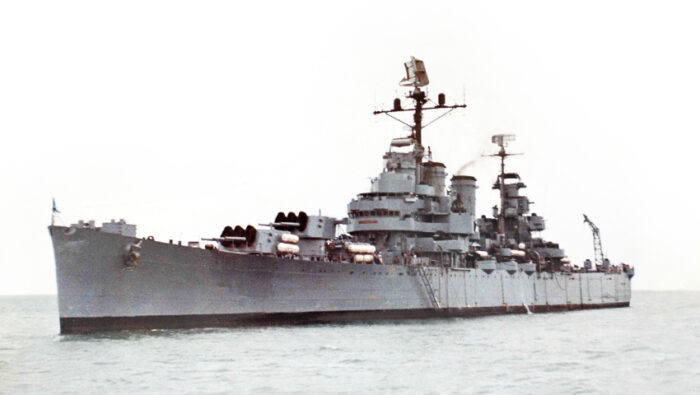
Belgrano before 1982, photo from Argentina.gob.ar.
In the 1950s the old cruisers of the USN were placed in selling list for brokers or potential customers, and such was the Brooklyn class. A deal was signed by the Argentinian government on 12 April 1951 for the delivery of two cruisers, USS Phoenix, and Boise. They were renamed ARA Diecisiete de Octobre and Nueve de julio respectively. These “stock” cruisers were still in their WW2 configuration, and apart 1945 radars and FCS, had little of anything looking like a modernization, limited to partial air conditioning, more modern intercom and communicaton center. Previously before being sold they had been refitted at the Philadelphia Navy Yard, with the superstructure reduced, added bulges and beam increased, mainmast derricks and catapult removed, but the hangar was kept. ARA General Belgrano (former Diecisiete de Octobre) housed two Alouette III helicopters in it. Commissioned in December 1951, both received Dutch electronics, new search radar in 1962, and two Seacat SAM were installed in 1967, making them “missile cruisers” at least in the press, which was far from the truth.

ARA Belgrano in April 1982
When the Falkland war commenced in May 1982, both had been relegated to amphibious support and gunnery training. On the 2 May 1982, Belgrano was at sea, escorted by two exocet-armed destroyers, stationed to the SW of the Falklands. Belgrano essentially was patrolling the 200 nm off the Burwood Bank when she was spotted by HMS Conqueror, a SSN arrived previously. The decision to fire was confirmed at the last moment by the PM, knowing that international consequences of such action were uncertain. After all, no ship of that importance had been sunk by a submarine since WW2. At 16h00 PM, greenlighted, she was torpedoed while sailing at 10 kts towards the mainland, 220 miles from the Falklands. She took two hits from Mk8** acoustic torpedoes, under the aft 5 in director and forward of A turret. Without power, she was dead in the water, while flooding progressed rapidly. She sank 45 minutes later, but still, 321 lives had been lost, 95% because of the both torpedo hits. The remainder 880 were rescued in 24h, all in life rafts. Nuevo de Julio was decommissioned in 1978, she served as a cannibalisation reserve for her sister ship until BU in 1983.
Development
Argentina being one of the major naval powers in South America over a century (With Brazil and Chile) had many cruisers during its existence. The rivalry with Chile which started in the 1880s already saw a flurry of acquisitions from protected to armoured cruisers, notably the famous Garibaldi class, still around in 1950. The interwar saw a replacement of older units with the two Italian built 21 de Mayo and British built school cruiser La Argentina. But to replace 1890 ships, Argentina needed more modern cruisers, especially in light of a possible acquisition of its first Aircraft carrier, ARA Independencia later in 1958.
Before it arrived, there were already 1890s cruisers which were scheduled for replacement. The post-1945 context was quite special as the USN, RN, RCAN had plenty of ships available for purchased, almost sold at scrap value. In the US, the flurry of wartime cruisers, both light and heavy made surviving interwar cruisers ripe for decommission. Those of the Brooklyn class were among these, kept in reserve whereas the Korea war started.

USS Phoenix in 1944
This class of large light cruisers typical of the London treaty were known for this. Sold for cheap, Brooklyn (CL-40) was purchased by Chile and became O’Higgins in 1951 just as USS Nashville (CL-43) as Capitán Prat, USS Philadelphia (CL-41) was transferred to Brasil as Barroso also in 1951. Soon, given the rivalry between these naval powers, USS Phoenix (CL-46) was transferred as Diecisiete de Octubre and USS Boise (CL-47) as Nueve de Julio. The US sold the two cruisers for 7.8 million dollars at the time to Argentina in 1951 with a deal negociated and concluded on 12 April. They had been completed originally in 1939-40 and saw already plenty of action in WW2, notably in the Pacific.
USS Phoenix had been notably flagship for admiral Kinkaid and Gen. Douglas MacArthur during the invasion of the Philippines in 1944. She received 11 battle stars for her service and was decommissioned on 3 July 1946 and Stricken on 27 January 1951 but not scrapped outright. The US Government was willing to help South American countries to modernized their navy and allow a purchase of these cruisers, which went to Brazil, Argentina and Chile about the same time in 1951 in part to avoid a repeat of past arms races, financially ruinous.

USS Boise off New York City in 1945
On her side, USS Boise served in the Pacific and Mediterranean. She took partr notably in the October 1942 Battle of Cape Esperance, Battle of Gela (Invasion of Sicily), landings at Taranto, New Guinea campaign and Battles of Wakde, Biak, Noemfoor, Sansapor, Morotai, the Philippines and Leyte invasion, Battle of Surigao Strait, Mindoro, Lingayen Gulf, Luzon, Bataan-Corregidor, Zamboanga, Borneo and Tarakan landings, carrying General MacArthur on a 3,500 miles (5,600 km) tour of the Philippines and Borneo. She was decommissioned in NYC on 1 July 1946. Actually she was not the lead ship but second in the “Belgrano class”, being immatriculated C5 while her sister 17 de Octubre was C 4 so the lead ship. Both were handed over at the same time and in the same average conditions. They were already pretty worn out when acquired and essentially of a 1935 design…
Design of the class
Most has been said already in detail about their design development history and detailed design in 1938, so check the Brooklyn article for more. We will concentrate here on their respective state in 1951 when handed over, and history of modifications (very few).
Design parameters
USS Boise started at 10,000 long tons estimated as design base, Washington-treaty obliged, 9,767 long tons (9,924 t) standard and 12,207 long tons (12,403 t) fully loaded at the end of the war.
She measured 600 ft (180 m) long overall for a beam of 61 ft 7 in (18.77 m) and mean draft of 19 ft 9 in (6.02 m) and up 24 ft (7.3 m) fully loaded.
It seems in 1951 she was a bit longer after the sternpost sponson, at 608 ft 4 in (185.42 m) but made wider after modification in drydock for the Argentinians, now bulged to 61 ft 9 in (18.82 m) overall for draft of 24 ft (7.3 m).
Powerplant
Powerplant did not changes for all their career. She had two screw propellers, two shafts mated on two Westinghouse geared steam turbines, fed by the steam produced by eight Babckock and Wilcox Steam boilers for a total of 100,000 shp (75,000 kW).
This ensured a top speed originally of 32.5 kn (37.4 mph; 60.2 km/h), but noted even in some publication to be 33.5 knots when handed over to Argentina. But the machinery was probably worn out by that stage, if not properly revised and components replaced. Range was based on an average of 1300 tonnes of fuel oil, for 10,000 nm at 15 knots. That put most of the Atlantic, from South Africa to Greenland, in her reach. Complement amounted to 868 officers and enlisted men.
Protection
They kept their prewar scheme unchanged, and had no Command Central unlike later wartime cruisers. They were also among the last with a conning tower. Here are the details below for both cruisers:
Belt: 3+1⁄4–5 in (83–127 mm)
Deck: 2 in (51 mm)
Barbettes: 6 in (150 mm)
Turrets: 1+1⁄4–6 in (32–152 mm)
Conning tower: 2+1⁄4–5 in (57–127 mm)
It should be noted that before being handed over, shipyard addition was made of ASW bulges to improve stability, which came alongside suprestructures curtailed to spare top weight. Their tail facilities, catapults and derrick crane were removed as well, as seaplaned were regarded as obsolete for reconnaissance (see later).
Armament
Originally they carried no less than fifteen 6 inches (152 mm)/47 caliber Mark 16 guns in five triple turrets, three forward, including “C” turret on deck, facing the bridge. The two forwards turrets like mounts A and B were superfiring. These were rapid-fire 6-inches models, very capable between a range of 20,000-yard (18,288 m) for the DP mounts at 22.3° elevation, 130-lb AP shell and 8–10 rounds per minute. In total, they could send to any target up to 150 shells a minute, once it was acquired by the latest 1945 tech guidance radars.
This was completed originally by eight 5 inches (127 mm)/25 caliber anti-aircraft guns placed in open sponsons and platforms along the main deck amidships. Althoygh less efficient than the 5-in/38 they still packed quite a punch and could double the main guns in amphibious bomardments, with 2,100 ft/s (640 m/s) average muzzle velocity, effective range of 14,500 yards (13,300 m) at 40° and 27,400 feet (8,400 m) at 85°, and 10 rpm, so 80 shells per minute.
originally this was completed by just eight caliber 0.50 in (12.7 mm) lquid-cooled Browning machine guns but of course during the war, this was augmented considerably with 20 mm and 40 mm mounts.
In 1946, USS Phoenix had four quadruple 40mm/60 Mk 2 Bofors and six twin 40mm/60 Mk 1 Bofors plus 19 single 20mm/70 Mk 10 Oerlikon AA guns.
On her side USS Boise in 1946 had the same for Bofors but 18 single 20mm/70 Mk 10 instead of 19.
In 1982, Belgrano had her AA reduced two two twin Bofors at the foot of the bridge forward, two quad Bofors upper aft close to the aft mast, and two more twins on deck close to the aft island structure, for 16 Bofors, no 20 mm AA.
Sensors
USS Phoenix had in 1946 the SK, SG, Mk 3, and two Mk 4 fire control radars. USS Boise had the same SK, SG, but also the Mk 13, and two Mk 28 radars instead.
In the early 1960s, both received new Ducth and US sensors, namely:
LW-01, DA-01, Mk 33, Mk 34 radars. They also had modernized fire control systems, two Mk 57 directors for their main guns and two Mk 63 directors and a NA9-D1 radar (Belgrano).
Seacat SAMs
Only one of the two cruisers really was rearmed in a sensible way. In 1967, just as new radars were installed on both vessels, General Belgrano alone received two quadruple Seacat GWS22 SAM Seacat missile launchers, for between 50 and 70 missiles depending on the sources. They were located on the upper wings of the bridge forward for the best arc of fire.
Seacat Mark 1:
Dimensions: 1.48 x 0.22 m (58 x 8.7 in)
Weight: 68 kg (150 Ib)
Propulsion: 2 stage motor
Top speed: Mach 0.8
Range/Ceiling: 500-1,000 m (1,600-16,400 ft)
Warhead: 18 ks (40 lb) continuous rods warhead, fuse.
Guidance: CLOS, radio link. They replace two twin Bofors mounts and were located high up abaft the aft mast and close to the main rear island structure.
ARA Belgrano in 1982 had still her main armament and eight 5-in secondaries, but few Bofors and 20 mm AA guns, except two on the bridge.
Air Group
Originally they carried Aircraft carried four SOC Seagull floatplanes, which replaced the disatrous Curtiss SOC3 Seamew served by two stern catapults and a derrick crane. It seems that if the former, as well as the hangar and aicraft were removed before transfer in 1982, the crane remained, notably to operate service boats. At some point they were equipped both with two helicopters. There was one Aérospatiale Alouette III on board Belgrano when she was sunk. The Alouette III was a 5-seat light liaison and reconnaissance helicopert (French Built). She was not intended for ASW work.

⚙ specifications Belgrano 1982 |
|
| Displacement | 9,575 tons (empty) 12,242 (full load) |
| Dimensions | 608.3 x 61.8 x 19.5ft (185.4 x 18.8 x 5.9 m) |
| Propulsion | 2 shafts West. geared steam turbines, 8× B&W Steam boilers, 100,000 shp (75,000 kW) |
| Speed | 32.5 knots (60.2 km/h; 37.4 mph) |
| Range | 1,321t fuel oil in 1982 for 10,000 nm/15 kts |
| Armament | 15× 6 in, 8× 5in/25 AA, 40/20 mm AA, 2x Sea Cat missile SAM |
| Protection | Main belt 5.5 in, Deck 2 in, barbettes 6 in, turrets 2, 6.5 in, CT 5 in |
| Sensors | See notes. |
| Air Group | |
| Crew | 1,138 officers and men |
Career
 Nueve de Julio (1951)
Nueve de Julio (1951)
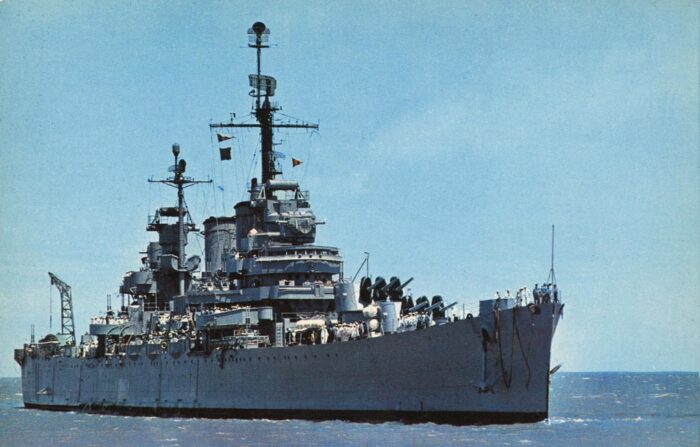
ARA 9 de Julio in the 1970s – credits Robert Hurst for navsource
USS Boise was sold on 11 January 1951, transferred on 12 April, and early in her service in the Argentine Navy, she took part in the 1955 Revolución Libertadora, shelling oil depots and military facilities in Mar del Plata with destroyers. On 19 September 1955. She was accidentally rammed by her sister General Belgrano during an exercise on 15 March 1956, both needed drydock repairs afterwards.
There are no detailed records for her activities between 1957 and 1971. The conomic situation did not helped, and due to maintenance costs she was seemingly inactive most of the time past 1968. Nueve de Julio was withdrawn from active service in May 1971 and remained moored at Puerto Belgrano Naval Base. By the mid 1970s, without proper maintenance she was found infested by rats, rusty and just unsafe. The inspecting commission observed such a level of decay that she was no linger serviceable. From March 1976 until at December she becale a clandestine detention center for the new Galtieri Regime. Many cabins became cells for detentions and interrogations ranging from days to months including torture, when conducted to the the headquarters of the Naval Establishment Police.She was ultimately stricken on 31 October 1977, sold for scrap on 28 June 1981 to a Brownsville, Texas company, at first with the idea of converting her and into a museum ship. But funds were never there and the project was dropped. Instead, she was resold and towed to Japan to be broken up for scrap in 1983. She was not survived by her sister Belgrano, which sank in 1982.
 ARA Belgrano, ex-27 de Octubre
ARA Belgrano, ex-27 de Octubre
USS Phoenix was after purchased christened “ARA 17 de Octubre” according the Loyalty day setup by the Peronist movement. She joined the Cruiser Division with ARA Nueve de Julio and during the coup d’état overthrowing President Perón in 1955, the Military Junta and Revolutionary Command negotiated a transfer of power to the Revolution aboard ARA 17 de Octubre. After the coup was completed, Vice Admiral Rojas changed the cruiser’s name oficially to to ARA General Belgrano, father of the country, Manuel Belgrano.
In 1967 she was modernized and received two quadruple Sea Cat missile launchers, becoming the very first Argentine missile ship.
No records for 1968-1977. Like her sister the internal situation in Argentina did not bode well with her maintenance, which degraded.
In December 1978, she took part in Operation Sovereignty, to reclaim the islands south of the Beagle Channel, actions stopped after an intervention of Pope John Paul II to avoid a war with Britain.
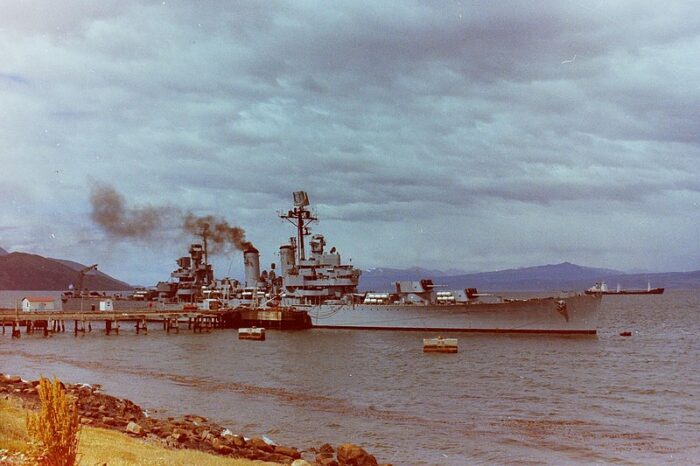
The General Belgrano photographed in Ushuaia on January 31, 1982.
At the start of 1982, she had 120 naval cadets aboard and sailed on a training mission to the far south of the country, and in the bay of Punta Este, carried live fire exercises with her full artillery in preparation for the incoming operation planned by the Galtieri junta.
Falklands War
On February 12, 1982, Belgrano set sail for her namesake port and Naval Base for her well needed yealry maintenance. Despite her new radar and missiles, like, but less than her sister, ARA Belgrano was in poor condition and could not reach more than 18 knots. Her captain at the time was Héctor Bonzo. The crew learned about growing tensions with the UK government prior the landings in the Falklands, notably incidents near South Georgia Island, where troops eveltually landed. Work had to be stopped as workers were requisitioned for other units and after loading food and supplies, the cruiser sailed out on April 2, notified of the planned amphibious operation ongoing. Fully crewed at 1,091 plus two civilians workers in the canteen which refused to leave her, she departed to join the Armada.
Meanwhile the British government deployed three nuclear submarines to the area and declared an exclusion zone of 200 nautical miles (370 km) centered on the center of the splitted Falkland Islands.
She was underway on April 16, 1982 as part of Task Group 79.3 with instructions to station off the Falklands, and followed a coastal route, parallel to the coast, trying to conceal intentions.
She was to monitor the southern approaches, intercept enemy units, deter British reinforceents, avoid tactical contact with enemy units armed with missiles (…) and if possible, to resupply at the Ushuaia Naval Base. Complete radio silence was ordered.
On April 19, it arrived at the “States Islands” to carry out firing exercises, finding jamming issues with her old Bofors ammunition. For this reason and to resupply she headed to the Ushuaia base.
On April 24, she returned to her former position, being reported the arrival of a British task force with two aircraft carriers and seven destroyers. GT 79.3 was ordered to remain where they were and off Namuncurá bank, to intercept enemy units that would potentially close in. GT 79.3 “Peñón TF” was joined by the destroyers ARA Bouchard and ARA Piedrabuena, oil tanker ARA Puerto Rosales.
Next she spent her days in exercises and reconnaissance missions by her sole Alouette III helicopter and n April 29, received her formal permission to use her artillery against any foe. On May 1 during a LOGOS operation, destroyers warned of an incoming British air attack which was an Argentine aircraft with radio problems. The Peñón group was ordered further south.
The sinking of ARA Belgrano
On May 2, the submarine HMS Conqueror judged despite she was outside the 200-mile radius military exclusion zone she was dangerous close and heading inside it as estimated. The British government was contacted and at 4:00 p.m. (Argentine time) on May 2, Margaret Thatcher’s meeting with her war cabinet near London gave the greenlight to the commander of Conqueror to proceed in the cruiser’s interception. The SSN launched four torpedoes (which were a WW2 model) on the Belgrano, two hirring her approximatively amidship. The cruiser started to flood rapidly and sank, carrying with her 323 of her crew. Her escort ARA Bouchard was also hit, but the torpedo was apparently a dud, while the remaining one narrowly missed the bow of ARA Piedrabuena. Both would imediately come to the rescue of the cruiser.
The following day, this made headlines acros the globe. For the first time since WW2, a submarine had sunbk in anger a large warship.
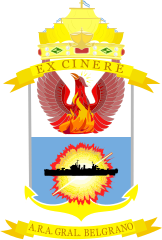 The coat of arms of ARA General Belgrano with the motto “EX CINERE” (Latin: from the ashes), recalling the legend of the Phoenix and alluding to its previous name, USS Phoenix. Argentina protested the sinking, as allegedly the ship was outside the British exclusion zone. The great loss of lives was also a national schock. The wreck of ARA General Belgrano was later rediscovered postwar and declared a war grave and national historic site, included in internaitonal nautical charts and geographic maps.
The coat of arms of ARA General Belgrano with the motto “EX CINERE” (Latin: from the ashes), recalling the legend of the Phoenix and alluding to its previous name, USS Phoenix. Argentina protested the sinking, as allegedly the ship was outside the British exclusion zone. The great loss of lives was also a national schock. The wreck of ARA General Belgrano was later rediscovered postwar and declared a war grave and national historic site, included in internaitonal nautical charts and geographic maps.
In 2003, a US National Geographic expedition came her for a survey with the Seacor Lenga with the support of the oceanographic ARA Puerto Deseado and corvette ARA Robinson. The search ended before a significant dive was made due to appealing weather conditions. Perhaps a future dive will establish precisely where she was hit and how she probably flooded. The sinking of Belgrano was enough of an event to generate many books and documentaries over the years. It was also the reason behind the retirement of the carrier ARA 21 de Mayo. Only modern vessels with adequate sonars were authorized close to the exclusion zone but the Argentinian Navy at large withdrawn and lef the rest of the campaign to its aviation, with more success.

Read More/Src
Books
Burzaco, Ricardo (1997). Acorazados y Cruceros De La Armada Argentina. Buenos Aires: Eugenio B. ISBN 987-96764-0-8.
Arguindeguy, Pablo (1972). Apuntes sobre los buques de la Armada Argentina (1810-1970). Buenos aires: Comando en Jefe de la Armada.
El Belgrano vive (Tercera edición). Instituto de Publicaciones Navales de Argentina. 2000.
Baccaro, Pablo E. (2013). Fuego 6, 1, 2 El Hundimiento del Belgrano: el hecho y la ley de la guerra
Burzaco, Pablo. Acorazados y cruceros de la Armada Argentina. Buenos Aires: Eugenio B.
Arguindeguy, Pablo (1972). Apuntes sobre los buques de la Armada Argentina (1810-1970).
Conway’s all the world’s fighting ships 1947-95
Links
https://www.navypedia.org/ships/argentina/arg_cr_17_de_octubre.htm
http://www.aposmalvinas.com.ar/benef079.htm
http://www.navsource.org/archives/04/046/04046.htm
http://www.aposmalvinas.com.ar/mapcrube.htm
http://www.cibernautica.com.ar/gralbelgrano/crucero.htm
https://um.edu.ar/en/noticias/el-recuerdo-a-40-anos-del-hundimiento-del-ara-belgrano/
https://www.monografias.com/trabajos4/crucerobel/crucerobel
https://www.infobae.com/sociedad/2020/09/13/a-65-anos-de-la-revolucion-libertadora-el-acta-completa-que-puso-fin-al-gobierno-de-juan-domingo-peron/
https://es.wikipedia.org/wiki/ARA_Nueve_de_Julio_(C-5)
https://es.wikipedia.org/wiki/ARA_General_Belgrano_(C-4)
Videos
Belgrano by Drachinfels
See also: youtu.be/l7JsD6LtzqQ and a survivor account

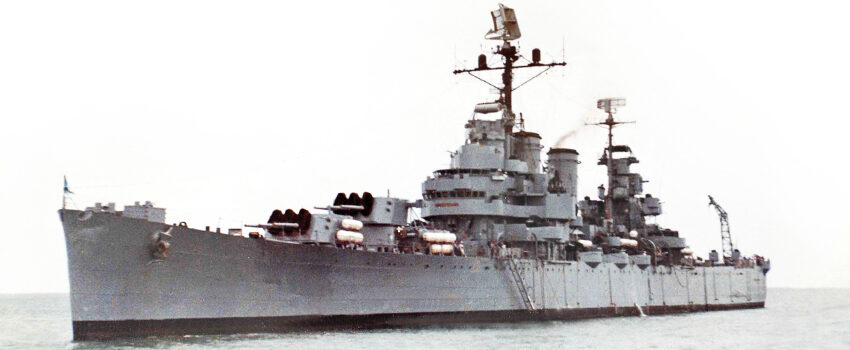
 Latest Facebook Entry -
Latest Facebook Entry -  X(Tweeter) Naval Encyclopedia's deck archive
X(Tweeter) Naval Encyclopedia's deck archive Instagram (@navalencyc)
Instagram (@navalencyc)





 French Navy
French Navy Royal Navy
Royal Navy Russian Navy
Russian Navy Armada Espanola
Armada Espanola Austrian Navy
Austrian Navy K.u.K. Kriegsmarine
K.u.K. Kriegsmarine Dansk Marine
Dansk Marine Nautiko Hellenon
Nautiko Hellenon Koninklije Marine 1870
Koninklije Marine 1870 Marinha do Brasil
Marinha do Brasil Osmanlı Donanması
Osmanlı Donanması Marina Do Peru
Marina Do Peru Marinha do Portugal
Marinha do Portugal Regia Marina 1870
Regia Marina 1870 Nihhon Kaigun 1870
Nihhon Kaigun 1870 Preußische Marine 1870
Preußische Marine 1870 Russkiy Flot 1870
Russkiy Flot 1870 Svenska marinen
Svenska marinen Søværnet
Søværnet Union Navy
Union Navy Confederate Navy
Confederate Navy Armada de Argentina
Armada de Argentina Imperial Chinese Navy
Imperial Chinese Navy Marinha do Portugal
Marinha do Portugal Mexico
Mexico Kaiserliche Marine
Kaiserliche Marine 1898 US Navy
1898 US Navy Sovietskiy Flot
Sovietskiy Flot Royal Canadian Navy
Royal Canadian Navy Royal Australian Navy
Royal Australian Navy RNZN Fleet
RNZN Fleet Chinese Navy 1937
Chinese Navy 1937 Kriegsmarine
Kriegsmarine Chilean Navy
Chilean Navy Danish Navy
Danish Navy Finnish Navy
Finnish Navy Hellenic Navy
Hellenic Navy Polish Navy
Polish Navy Romanian Navy
Romanian Navy Turkish Navy
Turkish Navy Royal Yugoslav Navy
Royal Yugoslav Navy Royal Thai Navy
Royal Thai Navy Minor Navies
Minor Navies Albania
Albania Austria
Austria Belgium
Belgium Columbia
Columbia Costa Rica
Costa Rica Cuba
Cuba Czechoslovakia
Czechoslovakia Dominican Republic
Dominican Republic Haiti
Haiti Hungary
Hungary Honduras
Honduras Estonia
Estonia Iceland
Iceland Eire
Eire Equador
Equador Iran
Iran Iraq
Iraq Latvia
Latvia Liberia
Liberia Lithuania
Lithuania Mandchukuo
Mandchukuo Morocco
Morocco Nicaragua
Nicaragua Persia
Persia San Salvador
San Salvador Sarawak
Sarawak Uruguay
Uruguay Venezuela
Venezuela Zanzibar
Zanzibar Warsaw Pact Navies
Warsaw Pact Navies Bulgaria
Bulgaria Hungary
Hungary

 Bundesmarine
Bundesmarine Dutch Navy
Dutch Navy Hellenic Navy
Hellenic Navy Marina Militare
Marina Militare Yugoslav Navy
Yugoslav Navy Chinese Navy
Chinese Navy Indian Navy
Indian Navy Indonesian Navy
Indonesian Navy JMSDF
JMSDF North Korean Navy
North Korean Navy Pakistani Navy
Pakistani Navy Philippines Navy
Philippines Navy ROKN
ROKN Rep. of Singapore Navy
Rep. of Singapore Navy Taiwanese Navy
Taiwanese Navy IDF Navy
IDF Navy Saudi Navy
Saudi Navy Royal New Zealand Navy
Royal New Zealand Navy Egyptian Navy
Egyptian Navy South African Navy
South African Navy






























 Ukrainian Navy
Ukrainian Navy dbodesign
dbodesign